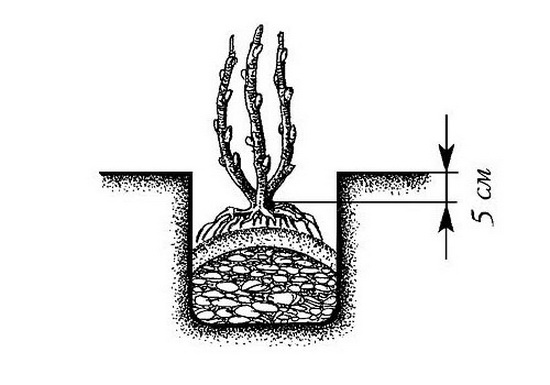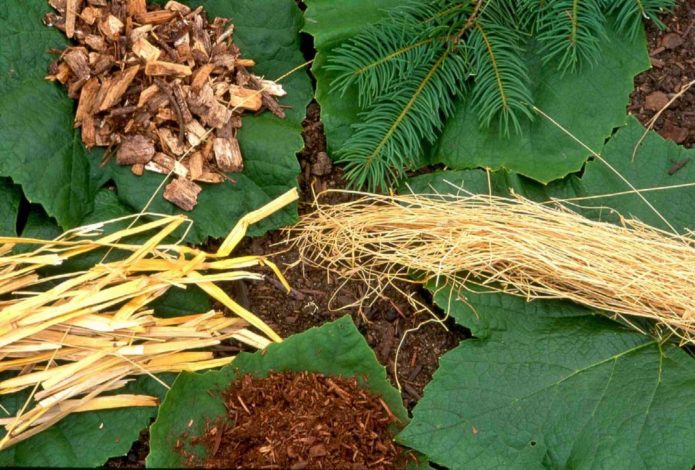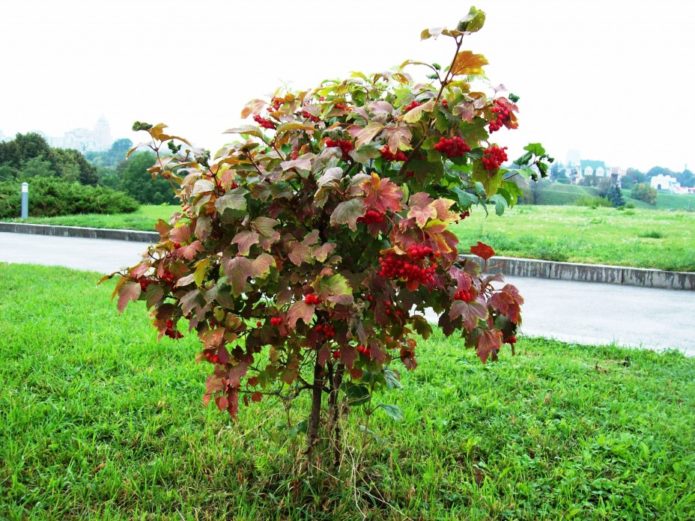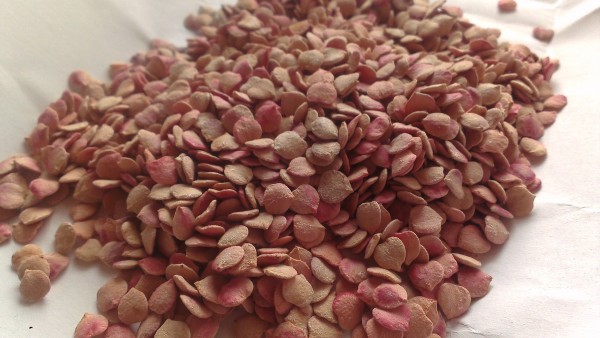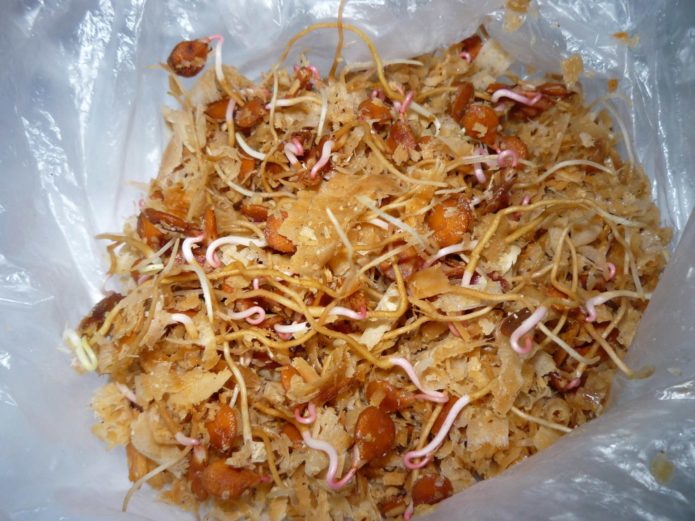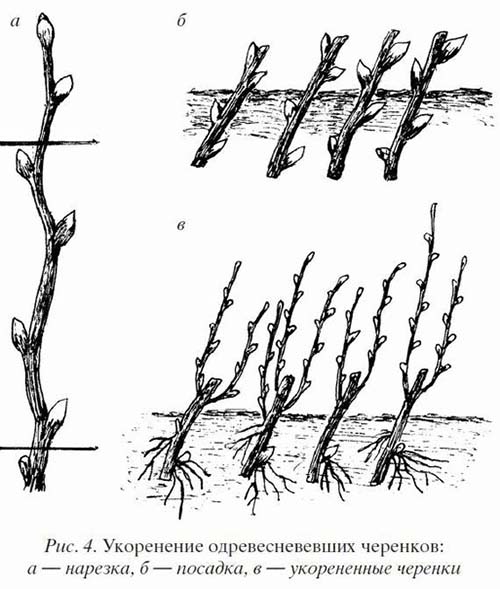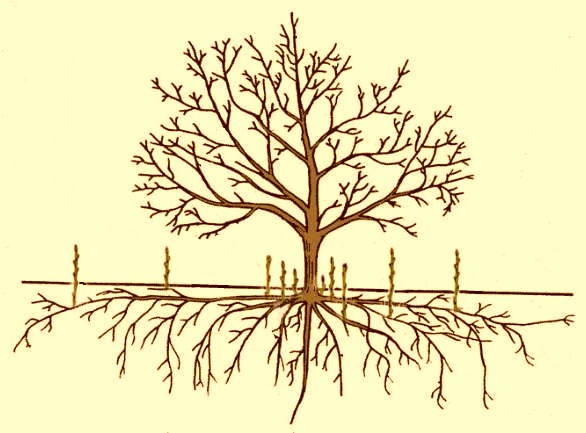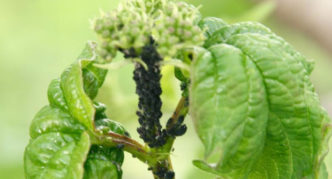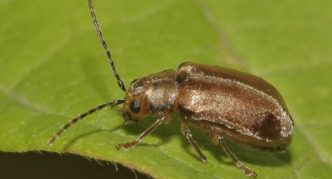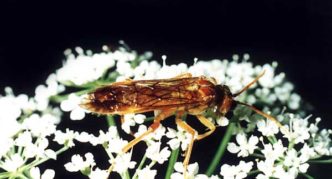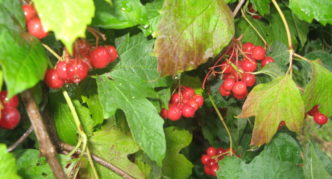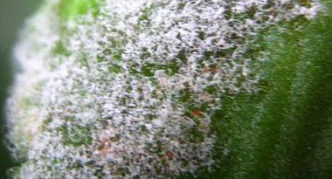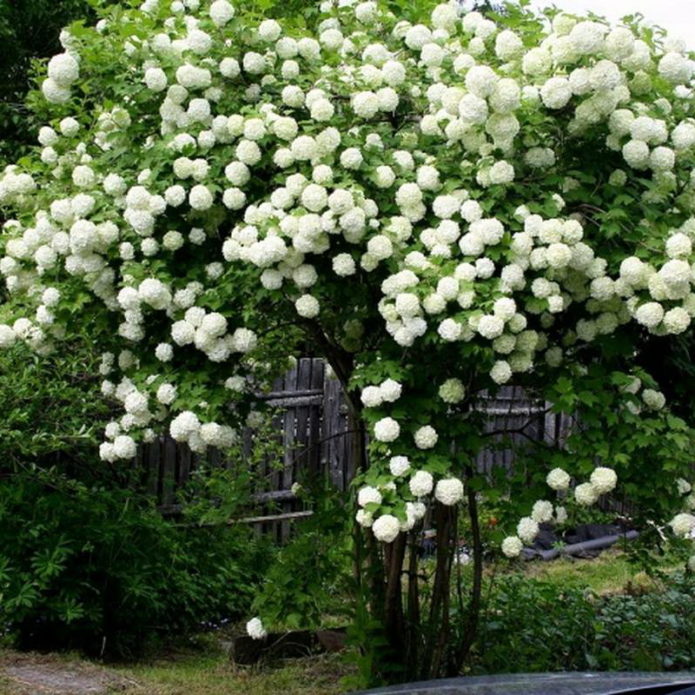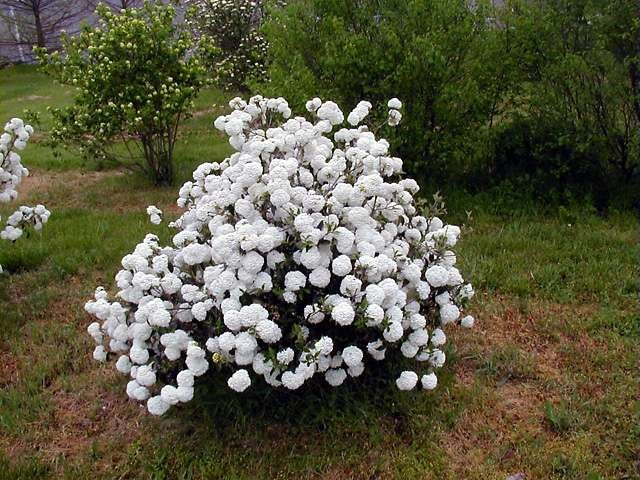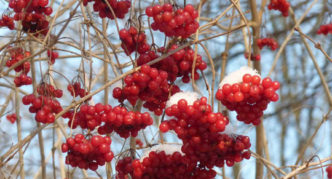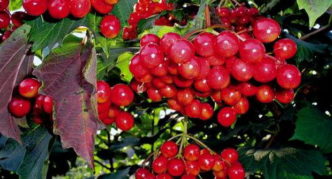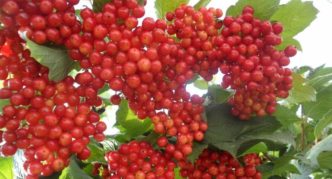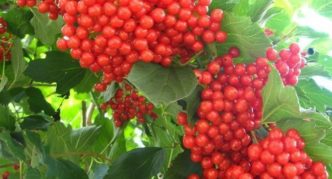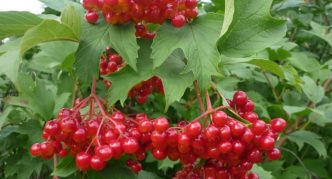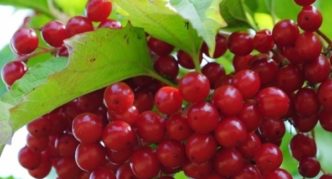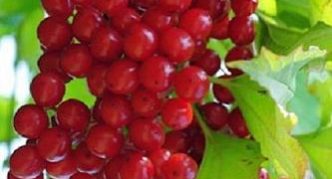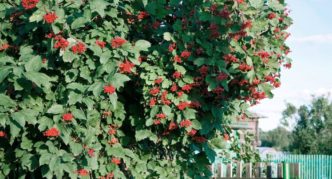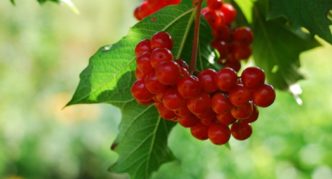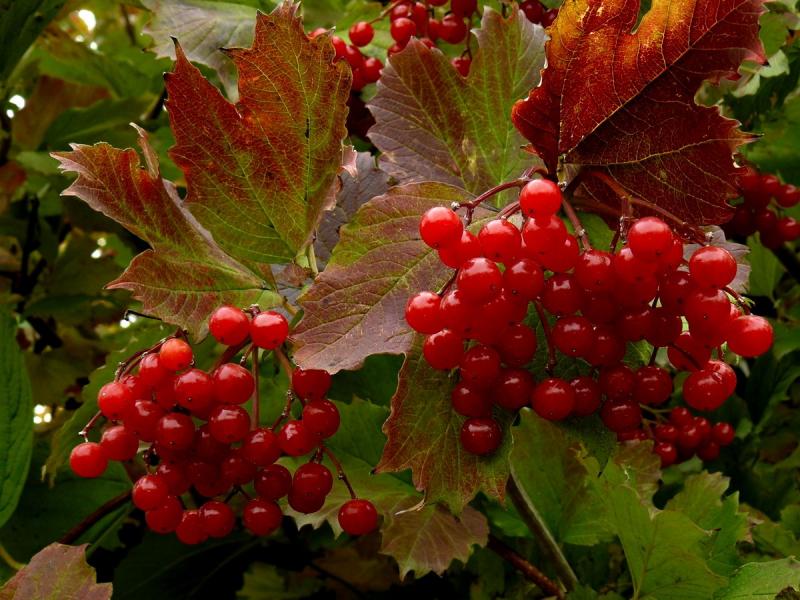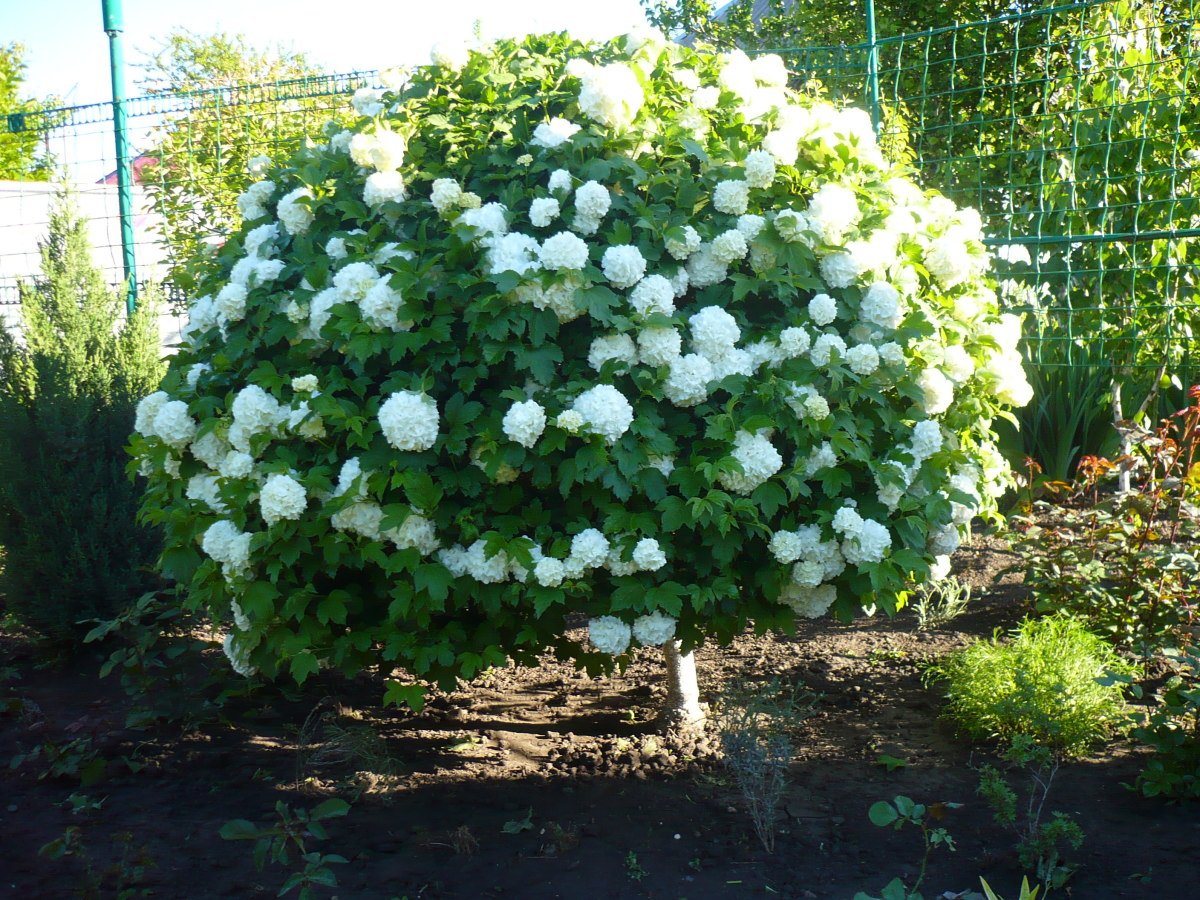Since the time of our distant ancestors, viburnum lived next to a person, many songs have been composed about it. In nature, it often takes the form of a shrub, but occasionally a tree can also be found. Of all the species diversity of viburnum (and botanists have described about 160 species), the common viburnum is most common in the Russian open spaces. The plant is of interest to gardeners for its decorative properties. Also, bitter fruits, which are used in the treatment of diseases, are processed for the preparation of tinctures, compotes, jellies. At present, varieties of viburnum with sweet taste have been obtained.
Content
Growing garden viburnum
Viburnum is unpretentious under natural conditions, but if you set yourself the goal of obtaining a large harvest and an attractive appearance, you must follow some rules of agricultural technology.
Choosing a place and a predecessor in the garden
You need to plant viburnum in a sunny place or in partial shade (including for the southern regions). The plant prefers soils with a neutral or slightly acidic reaction (pH = 5.5–6.5).
Viburnum bears fruit more abundantly, if you plant 2-3 bushes next to it. The distance between them is at least 3 m.
The plant achieves the best development on fertile air-permeable soils, grows poorly on podzolic, sandy, swampy. The depth of groundwater table must be at least 1 m. The previous growth of vegetable legumes (peas, beans, etc.), the roots of which saturate the earth with nitrogen, has a beneficial effect on the site of the proposed planting of viburnum.
Soil preparation
For planting viburnum, it is advisable to dig up the planting site in advance and add 1 bucket of rotted manure or compost. If the soil is too acidic, then it can be deoxidized in advance: loamy - with lime, sandy and sandy loam - with dolomite flour or chalk.
Planting and transplanting
Viburnum can be planted in the spring, before the first leaves bloom, but it is allowed to do this in the fall - before the onset of the first frost. It is more expedient to plant small seedlings, because it will be easier for them to adapt to new conditions, they will grow faster. It is better to purchase seedlings with a closed root system, for example, in a container. However, they will have a higher price. When buying a seedling with an open root system, pay attention to:
- development of the root system;
- the presence of mechanical damage to the roots;
- the presence of putrefactive spots on the roots:
- freshness of the roots (if you scratch the bottom of the rhizome, then a greenish wood should appear).
Landing procedure:
- Prepare a planting pit with a diameter of 60 cm and a depth of about 40-50 cm.
- Add 1 bucket of rotted manure or compost to it, mix it with the upper part of the soil taken out when digging a hole.
- Plant the seedling by spreading the roots. When planting, you need to try to achieve the location of the root collar of the seedling 3-5 cm below ground level.
- After planting, pour the viburnum seedling with 4 buckets of water, and mulch the place around the trunk.
It is better to transplant viburnum with a lump of earth, so as not to cut off many small roots.
Video: features of planting and caring for viburnum
Care
Viburnum develops better with sufficient soil moisture, therefore, during the dry season, it must be watered several times a week. It is necessary to ensure that the top of the soil is always moist. But it is also not worth pouring the planting hole to the degree of slurry formation, it harms the plant. After watering, the soil around the seedling must be loosened.
Experts advise feeding the plants annually:
- 12 g of potassium salt;
- 30 g of nitrogen-containing substances;
- 50 g superphosphate.
For gardeners who prefer organic fertilizers, it is suitable to apply 2-3 kg of rotted manure or compost per 1 m to tree trunks once a year2 area.
It is advisable to mulch the trunks around the viburnum. For mulch, you can use straw, tree bark, grass cut before the period of its insemination, etc.
Mulching allows not only to preserve soil moisture for a long time, but also contributes to the development of beneficial soil microflora, as well as earthworms. This increases the natural fertility of the soil.
Trimming and shaping
Pruning viburnum for sanitary purposes is carried out in the fall, after the leaves fall. It is advisable to choose a warm day without rain for this event. Dried, diseased shoots and branches affected by harmful insects are cut out. Slices with a diameter of more than 7 mm are covered with garden pitch.
Pruning for the formation of the crown is carried out in the spring, before the leaves begin to bloom. Viburnum is formed depending on the goal: to give the plant the shape of a tree or a bush. If you want it to develop in the form of a tree, then:
- Leave one branch growing vertically and cut the rest.
- Remove the buds on the stem where you plan to create the stem.
- When the trunk reaches a height of 1.5–2 m, pinch the growth point. This procedure stimulates branching.
- While the trunk is growing to this height, cut down the basal shoots and cut out the side branches on the trunk.
It is advisable to cut off the viburnum growing by the bush, because with age such a crown grows and thickens. This interferes with harvesting, and the quality of the berries will subsequently be worse.
Reproduction
Viburnum can be propagated by seeds, cuttings, basal shoots.
Seed propagation
It is useful to know that without special measures, viburnum, when propagated by seeds, can germinate from a year to 3 years. In order for the seeds to germinate faster, they are subjected to special treatment.
The procedure for propagating viburnum seeds:
- The new crop planting material is mixed with moistened sawdust and placed in nylon stockings. They are stored in this way at a temperature of + 20… + 25ºC for 2 months.
- When small sprouts appear on the seeds, they are transferred to the lower part of the refrigerator for 1 month, then they are sown in boxes, deepening 3-4 cm into the soil, and sprouting is awaited.
- In the spring, when the threat of frost return has passed, the seedlings are planted in the nursery, watered, and initially protected from direct sunlight.
Propagation by cuttings
Viburnum cuttings are cut during the flowering period of the plant, when the shoot is filled with juice. This happens in June or early July.
Procedure:
- A 10–12 cm segment is cut from the middle part of the shoot, on which there are 2–3 nodes. A cut is made at the bottom at an acute angle, the lower leaves are cut off, and 2-3 leaves are left at the top.
- The cut at the bottom of the cutting is treated with Kornevin or kept for 10-12 hours in an aqueous solution of Heteroauxin.
- The cuttings are transplanted into a mixture of pure sand and peat, which is prepared in a 1: 1 ratio. They are buried 1–2 cm, keeping a distance of 4–5 cm between them.
- Then the cuttings are covered with transparent material, keeping the air temperature + 27… + 30ºC inside the shelter at high humidity, for which they are periodically sprayed with water.
- After about 20-21 days, when the cuttings take root, they begin to accustom them to the usual environment, removing the protective cover for a while. After the final adaptation, the shelter is removed completely. They are left indoors for the winter.
- With the arrival of climatic spring, the cuttings are hardened for 2 weeks, then transplanted into an open nursery, following the planting scheme 50x15 cm.
- When the seedlings grow enough, they are transplanted to a permanent place.
Reproduction of viburnum by root shoots
Reproduction by basal shoots is considered a relatively uncomplicated method. For this:
- In May or June, root shoots of a bush 20 cm or more high from the ground are chosen.
- The base of the shoot is pulled with wire, then hilling is carried out to a height of 7–8 cm.
- During the summer, the shoots are spud 2-3 more times, achieving a pile height of 20 cm.
- The following spring they are cut off from the mother bush and planted in a permanent place.
Protection against diseases and harmful insects
Viburnum leaves often suffer from the invasion of harmful insects:
- viburnum leaf beetle;
- viburnum leafworm;
- black viburnum aphid;
- viburnum gall midge;
- honeysuckle prickly sawfly.
In addition, viburnum is affected by diseases:
- powdery mildew;
- fruit and gray rot;
- spot on the leaves.
There are several approaches to protecting viburnum from harmful insects and diseases, including the use of modern chemicals and formulations obtained from natural ingredients.
The use of artificial drugs is effective, but it should be borne in mind that carriers of diseases and pests mutate over time, getting used to substances that were previously destructive for them. With all the precautions (spraying before flowering, etc.), there remains a risk of a harmful composition entering the human body.
The use of natural natural ingredients is practically harmless to human health, but it is not always effective due to the adaptation of pests and disease carriers to them.
Photo gallery: pests of viburnum
- Viburnum leafworm is a harmful caterpillar
- Black viburnum aphid infects leaves
- Viburnum leaf beetle eats leaves
- The honeysuckle prickly sawfly poses a threat to viburnum
- Viburnum gall midge affects viburnum trees
Photo gallery: viburnum diseases
- Spotting affects viburnum leaves
- Viburnum berries suffer from fruit rot
- Powdery mildew often affects viburnum
Pest control methods
To combat the viburnum leaf beetle with the onset of spring, when the leaves on the viburnum have not yet blossomed en masse, the tops of the shoots are carefully examined for the detection of a clutch of pest eggs. The tops with it are cut off and burned.
Viburnum leafworm, viburnum gall midge, honeysuckle prickly sawfly are destroyed by spraying the viburnum in the period before flowering with a 10% solution of Karbofos. Alternative means of controlling these pests are to spray the crown:
- infusion of pepper;
- wormwood broth;
- infusion of tomato tops.
To destroy the black viburnum aphid, shoots growing at the roots are cut out and burned. There the pests lay their eggs before the onset of winter. Some experts recommend treating shoots in the period before bud break with Nitrafen at a concentration of 60%. Folk remedies also help:
- infusion of potato tops;
- laundry soap diluted in water;
- garlic solution.
Aphids are also destroyed by widespread insects: ladybugs, lacewings.
Disease control methods
To combat powdery mildew, fungicides are used:
- Speed;
- Topaz;
- Byleton, etc.
Among folk remedies, an infusion of onion or field thistle is used.
When the viburnum is affected by fruit and gray rot, diseased leaves and fruits are cut off and burned. The plant is sprayed with:
- bordeaux mixture;
- Vectra drug;
- copper oxychloride.
To eliminate spotting, the affected leaves are removed and burned. Until the leaves appear, branches and shoots are sprayed with copper oxychloride or Bordeaux mixture.
Varieties and varieties of viburnum, their features
Recently, many varieties and varieties of viburnum have been bred, with attractive decorative properties and a peculiar taste of berries.
Varieties of viburnum with increased decorative properties
Viburnum crowns often delight the eye with their beauty, but there are several varieties that are of greatest interest due to the special attractiveness of their appearance.
Kalina Roseum
First of all, this variety of viburnum is valued for its snow-white flowers 1.5 cm in size, which are collected in balls of inflorescences up to 10 cm in diameter. At the beginning of flowering, they have a greenish tint, at the end - pinkish. The plant blooms from May to June. Roseum viburnum flowers are sterile, therefore they do not form fruits.
The variety is a tall shrub with a lush and spreading crown in height and a diameter of 2 to 5 m. Green leaves in autumn are painted in red-orange tones.
Viburnum Snow Globe
Variety of viburnum Snow Globe, or Buldenezh (from the French boule de neige - snowball) grows up to 3.5 m. The branches form a wide crown. To enhance the effect of the perception of magnificent white inflorescences (up to 15 cm in diameter), gardeners give the crown of the bush a hemispherical shape. The flowers of the Viburnum Snow Globe are also sterile and do not bear fruit.
The plant begins to bloom in May and lasts about a month. At first, the buds are pale green in color, then their shade changes to cream or pale pink, finally, when fully blooming, they become snow-white. In autumn, the leaves are of a beautiful crimson color.
The bush lives for a long time and still blooms until the age of 60.
Kalina Sargent "Onondaga" (Onondaga)
Refers to the type of viburnum Sargent. Hardy, shade-tolerant. The leaves are bright green, large, 12x10 cm in size. The inflorescences of this plant are decorative: in the center are fertile buds of a red-burgundy hue, and the circle is framed by large (up to 3 cm in size) white sterile flowers. Flowering occurs in June.
Unlike the previous ornamental varieties, the Sargent "Onondaga" viburnum bears fruit in September. The fruits are juicy, small, orange-red.
Kalina Eskimo
The flowering of this plant is so abundant that shoots and branches are almost invisible. It is formed in the form of a spherical bush or tree with a stem of about 0.6 m with a rounded crown. The leaves are dark green, shiny, leathery, ovoid.
Flowering begins in the second half of May and lasts a long time. Large (up to 10 cm in diameter) snow-white inflorescences-balls exude a pleasant aroma.
Viburnum Eskimo grows slowly.
Viburnum fruit varieties
Breeders have also bred fruit varieties.
Table: characteristics of fruit varieties
| Variety name | Description of the variety |
| Leningrad elite | The bush is medium-sized, 2–2.5 m high, frost-resistant, mid-season. The variety is self-fertile, therefore, to obtain a harvest, a close arrangement of viburnum of other varieties is required. The fruits are large, round, of pleasant taste with noticeable sweetness, the color is ruby-red. The plant prefers lighted places. The bush has a medium spreading crown |
| Ulgen | Mid-season variety (fruits ripen in mid-September), the name of which comes from the Altai phrase "good spirit". The bright red round fruits are covered with dense skin and have a sweetish, bitter taste. Fruit cluster consists of 35-50 juicy drupes. Shrub up to 4 m high, yields 5-10 kg. Differs in resistance to diseases and aphids. Responds well to watering |
| Taiga rubies | A medium-ripening variety that gets its name from its beautiful bright ruby ball-shaped berries. Fruits are round, medium in size with yellow pulp, weighing 0.5-0.7 g, sweetish, slightly bitter taste. The plant develops as a shrub with a rounded oval crown or tree. Productivity - 8-11 kg per bush. Fruiting begins at the age of 4, occurs regularly, without a decrease in yield up to 20 years. When planting this variety of viburnum, it is necessary to take into account that it is self-fertile and needs pollination of other varieties and seedlings of common viburnum |
| Red bunch | Mid-season variety, bred by employees of the Michurin All-Russian Research Institute of Genetics and Breeding of Fruit Plants. Average yield, 2.5-4 kg of berries per bush. Resistant to diseases and pests. The berries are spherical, large, of dark burgundy color, sweet and sour taste with pleasant bitterness. The bush is medium-sized. The variety is self-fertile, but experts advise to plant at least one viburnum bush of another variety next to it to increase yields |
| Zholobovskaya | The variety was obtained at the N.I. M. A. Lisovenko. Shrub up to 2.5 m high. Shoots are smooth, light gray in color. Green leathery leaves of medium size, 3-5 lobed. The dark red globular fruits ripen in late September. The berries are juicy, of medium size (0.6–0.7 g), with a good slightly bitter taste. Productivity - about 5 kg per bush, annual fruiting. The variety is winter-hardy, disease-resistant. Self-infertile, therefore it needs a neighboring arrangement of viburnum bushes of other varieties |
| Maria | The mid-season variety is named after the breeder Maria Plekhanova. A bush with thick shoots, up to 3 m high. The leaves are green, wrinkled, in autumn they turn purple and golden. In the fruit cluster there are 45-50 rounded berries of light red color, weighing 0.6 g. The taste is sweetish-sour with a slight tart shade. Bears fruit annually. Productivity - 5 kg per bush. The variety is winter-hardy. Differs in high resistance to diseases and pests |
| Shukshinskaya | The variety is named after the truly popular writer, actor and director V. M. Shukshin, who shot the piercing film "Kalina Krasnaya". Medium ripening. A bush with thick light gray shoots, up to 3 m high. The leaves are light green, 3-5 lobed. The berries are crimson-red, weighing 0.57 g. The taste is slightly bitter. Fruiting is stable. Average yield - 6 kg of fruits per bush. The variety is winter-hardy, disease-resistant. Demanding on soil moisture. Self-sterile. All varieties of viburnum are suitable for pollination of flowers. |
| Michurinskaya early | An early ripe variety bred at the N.N. I. V. Michurin. Differs in the large size of spherical red berries - up to 1 g. Fruits have a sweetish slightly bitter taste, they can be consumed fresh. The yield is high - up to 10-15 kg per bush. High bush, up to 4 m. Winter-hardy variety |
| Red coral | Bred by breeders of the V.N. I. V. Michurin. Also a large-fruited variety, a mass of bright red spherical berries - up to 1 g. The taste of fruits is sweetish, slightly bitter with a strong aroma. The yield is high - more than 10 kg of fruits per bush. The bush is medium-sized, compact.The variety is self-fertile, can be used for pollination of self-fertile varieties of Viburnum vulgaris |
| Cherished | The variety is of medium ripening. The bush is medium-sized, with straight shoots of medium thickness. Winter hardiness is high. Bright red berries have a spherical shape, weight - 0.74 g. The taste is sweet and sour with a slight bitterness. Productivity - about 2.5-4 kg of fruit per bush. The variety is self-fertile; to obtain a harvest, the neighborhood of other varieties of viburnum is necessary |
| Zarnitsa | The variety is of medium ripening. Tall bush - up to 3.5 m - with light gray smooth shoots. The leaves are green, large, with 3-5 lobes. Fruits are bright red, elliptical, weighing 0.6–0.8 g. Bitter taste. The variety has a technical purpose, the fruit makes a good jam. Average yield - 6.5 kg per bush. Fruiting steadily, does not reduce yield up to 25 years. Resistant to diseases and pests. Self-infertile, all varieties of viburnum are used for pollination |
Photo gallery: fruit varieties of viburnum
- Kalina Michurinskaya early has large berries
- Viburnum Maria has many fruits in the brush
- Kalina Zarnitsa is a technical grade
- Kalina Ulgen is considered a fruitful variety
- Kalina Red bunch is a mid-season variety
- Viburnum Zholobovskaya berries ripen at the end of September
- Viburnum Red coral gives high yields
- Viburnum Cherished medium ripening
- Kalina Shukshinskaya named after a Russian writer
- Viburnum has Taiga rubies bright ruby berries
.
Performing simple agricultural techniques, you can decorate your garden with magnificent viburnum crowns and flowers, as well as get a harvest of healthy sweetish fruits with a characteristic bitterness.

